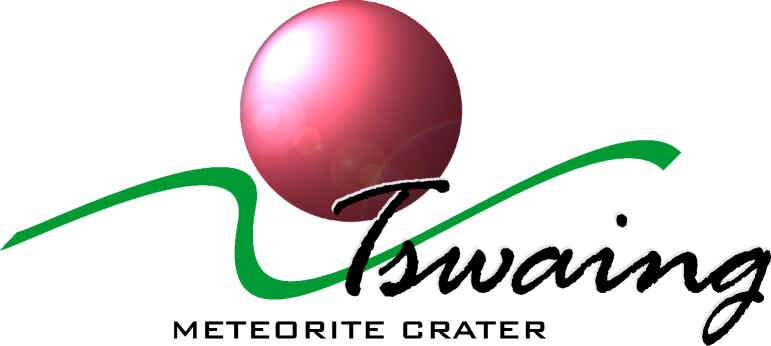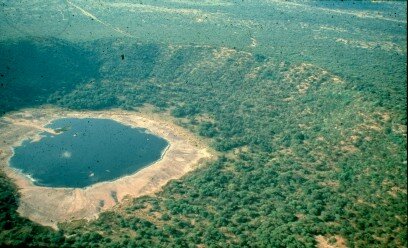|
Aerial view of crater (photo by the late Herman Potgieter, courtesy of Department of Geology, University of the Witwatersrand) |
 |
|
What is Tswaing? |
|
|
Some 220 000 years ago a blazing stony meteorite the size of half a football field slammed into the earths crust. The impact formed a huge crater, 1,4 km in diameter and 200 m deep. This crater, known as the Pretoria Saltpan (or Zoutpan), is situated 40 km north to the northwest of Pretoria. It is one of the best-preserved meteorite impact craters anywhere in the world. The name Tswaing means Place of Salt in Setswana, one of the eleven official languages in South Africa. This name refers to a saline lake that covers the crater floor. As early as 120 000 years ago Stone Age people, and later ancestors of the San, inhabited the area. About 800 years ago, black people who spoke African languages like Tswana and Sotho moved into this area. Later people lived in the proximity of the crater, tending their cattle, growing crops and collecting salt from the crater floor. The lakes salt and soda attracted white hunters and settlers, who demarcated the area into a farm and named it Zoutpan, and from 1912 to 1950 an industry producing soda ash and salt was based at the crater. The former National Cultural History Museum took over the farm Zoutpan from the Department of Agriculture in 1993 to develop it into an ecotourism destination for environmental education, recreation and research. This became the Tswaing Crater Museum. In December 2001 the name was changed to Tswaing Meteorite Crater. Major attractions, besides the crater, are an extensive wetland system; the large variety of plant species, representing different plant communities typical of the Sourish-Mixed Bushveld, and wildlife, in particular the 240-odd species of birds found at this site. From the various layers of the sediment which accumulated in the crater over thousands of years, the most detailed history of climatic change in the southern hemisphere can be read. From the start, the Tswaing project has invited community participation in its planning and development. Local communities have already been benefiting from the museum project through job creation, skills training, environmental education, income-generating projects and tourism. |
|
| All intellectual property rights, including but not limited to copyright and trademarks, vested in the material contained on the NFI website is held by the NFI and may not be copied, reproduced, adapted, published or distributed in any form whatsoever without the prior written consent of the responsible person at the NFI. | |
